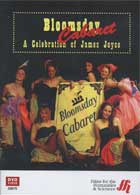
Bloomsday Cabaret: A Celebration of James Joyce 2006
Distributed by Films Media Group, PO Box 2053, Princeton, New Jersey 08543-2053; 800-257-5126
Produced by Rosemary House
Directed by Rosemary House
DVD, color with b&, 49 min.
Sr. High - Adult
Biography, Literature, Music, Travel & Tourism, Writing
Date Entered: 10/12/2006
Reviewed by Kim Davies, State University of New York at GeneseoSecond only to St. Patrick’s Day, Bloomsday is Dublin’s greatest celebration and tourist event. On this day, June 16th, aficionados of James Joyce’s Ulysses travel from all over the world to rejoice, remember, and recreate the 24-hour wanderings of the novel’s main character, Leopold Bloom. Bloomsday Cabaret: A Celebration of James Joyce tells the story of a few Joycean enthusiasts who arrive in Dublin, on Bloomsday’s 100th anniversary, from St. John’s, Newfoundland in Canada.
Rather than simply recount Joyce’s writing, producer Rosemary House includes the importance of music throughout his masterpieces. Whether readers are aware of the prominent folksongs mentioned in Joyce’s works (there are references to over 100 songs in Finnegans Wake) or they recognize Joyce’s style of writing as a masterful composition of lyrics, melody and rhythm, it cannot be argued that music is everywhere in such pieces as Ulysses, Finnegans Wake and The Dead. Bloomsday Cabaret opens our auditory senses and places us in settings that we can only imagine Leopold Bloom to have experienced. After an impressive and lively introduction to the documentary, viewers find themselves in Sandycove, a small bayside town south of Dublin, where Joyce wrote Chapter I of Ulysses in one of Ireland’s original 50 martello towers. Sounds of waves crashing upon the rocky coastline, the squawk of seagulls hovering above, and the call from one gentleman swimmer to another in Dublin’s Forty Foot swimming hole allows one to imagine themselves walking along the beach of Dublin Bay. Furthermore, the colorful costumes of the early 1900’s, impromptu sessions of guitars, violins, bodhrans, and flutes, and the sights and sounds of a bustling city along the River Liffey transports viewers back to “Dear Dirty Dublin” – a “paralyzed” city that Joyce deeply despised but ironically immortalized in his writing.
With background music, readings from James Joyce’s most famous works, and interviews with journalists, Joycean scholars, and even Joyce’s own nephew, Bloomsday Cabaret provides a biography and perhaps some explanation behind Joyce’s literature, which has been frequently criticized as inaccessible and unreadable. It only takes a few minutes for readers to be completely perplexed and frustrated by Joyce’s stream of consciousness and mixed use of nearly 30 languages in Finnegans Wake.
The audio is extremely crisp in this documentary and the juxtaposition of Dublin Then, through black and white photography, and Dublin Now, with its lively streets, open air markets, and serene parks, paints a vivid picture of this historically struggling city which Joyce depicted so clearly. As complicated as Joyce’s writing can be, it seems only reasonable that high school students should be the youngest audience able to fully appreciate Bloomsday Cabaret and its celebration of Joyce’s life and works. However, the most fitting audience for this documentary would be undergraduate and graduate students (English majors, in particular) who study James Joyce in greater depth and detail.